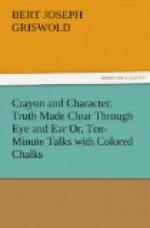It is well for the beginner to cultivate an individual style of speaking. Substitute your own methods of expression in place of the language of the book. The more you do it, the larger will be the feeling that the message is a personal one from you to your hearers. Whenever you can do so, substitute a “home” illustration for the one in the book. As you become more accustomed to the work you will doubtless use pictures and subjects entirely outside of the book. Remember that any outline picture may be enlarged after the method here shown. Cut your picture into squares with drawn lines, and enlarge it in the same manner. Many Bible scenes may be shown in this way.
International or Graded Lessons.
The book has been provided with two indexes. One directs you to fitting talks for special days. The other serves as a guide to talks and illustrations suitable to the application of any lesson. Determine the central thought of the lesson and consult the Subject Index. It will help you choose a talk appropriate for the day. The talk may need a little revision to enable you to give it the proper application, but the main thought will be readily apparent.
Talks for Special Days.
The index for suitable talks for special days includes some which are not yet generally observed but which are of growing importance. Introducing some of these into your school or church as novelties, they may become as permanent as Easter, Children’s Day, Rally Day and others.
Talk vs. Chalk.
No matter how little preparation you may need for your talk, remember that the words you speak are of greatest importance. It is to your words that you must give careful study, or your audience may lose the force of your thought while centering their attention upon the developing picture.
Never apologize for the appearance of your drawing or of your ability as an artist. Strive to present truth only. Truth needs no apology.
Do not draw in a sketchy manner. Determine on the place to begin your drawing and then use a continuous, easy line, without lifting the chalk from the paper, except when necessary to start in a new place.
Strive Only for Good.
The design of this book has been to present brief, impressive talks which hold attention for from ten to twelve minutes. It is advisable never to speak longer than this, especially when children form a part of your audience and are the special object of your words. If you cease speaking just when the audience wants to hear more, you will always be assured of a hearing the next time. If you leave one single wholesome thought with your audience you will have accomplished the greatest good.
Avoid mannerisms. Cultivate an easy style of speaking and working. Don’t become discouraged if everything doesn’t go to suit you. Your audience is not a critical but a sympathetic one. All are striving to do the Master’s work, and the field you have undertaken will bring you the interest and the kindliest co-operation of all who are working with but one great object in view.




